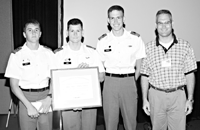The 2001 Mathematical Contest in Modeling
May 9, 2001

As in this year's Mathematical Contest in Modeling, the SIAM winners in MCM 2000 were the teams from the U.S. Military Academy (for the continuous problem) and Wake Forest University (for the discrete problem). Shown here in Puerto Rico, where they presented their winning paper for the "Air Traffic Control" problem, are 2000 USMA team members (from left) Kevin Arnett, Jonathan Gibbs, and John Horton, with their faculty adviser, Major David Bailey. Not pictured is the Wake Forest team, which turned in the winning solution to the discrete problem, "Radio Channel Assignments"; the team members were Daniel Durand, Jacob Kline, and Kevin Woods, and their faculty adviser was Edward Allen.
The Mathematical Contest in Modeling (MCM) is seventeen years old and still growing. More teams (496) from more countries (11) participated in 2001 than ever before. Two hundred fifteen of the three-person teams elected to work on the "continuous" Problem A, while 281 chose the "discrete" Problem B. A total of nine papers---three on Problem A and six on Problem B---were judged "outstanding," while 70 were deemed "meritorious" and 123 earned "honorable mention." It is expected that at least five of the "outstanding" papers will be published later this year in the UMAP Journal.
This year's A problem involved the choice of a wheel for a particular bicycle race. Solid wheels---which are heavier but more aerodynamic than those with traditional wire spokes---are ordinarily used for indoor races, but their use as front wheels is not permitted in sanctioned road races. On certain outdoor courses, however, they can be and sometimes are employed as rear wheels. The decision on their use is ordinarily based on the number and steepness of the hills to be negotiated, as well as weather, wind speeds, and levels of competition. The teams were asked to provide, among other things, a table indicating the wind speeds and road grades for which solid wheels would require less power than spoked wheels.
The B problem had to do with evacuation plans for the South Carolina coast on the eve of a hurricane. In 1999, when Hurricane Floyd threatened to wreak havoc up and down the coast, evacuating residents formed monumental traffic jams. Such was the congestion that the two-hour drive from (coastal) Charleston to (inland) Columbia along the main connecting artery (I-26) required as much as eighteen hours to complete, even for those blessed with the good sense and good fortune not to run out of gas. A nightmare was avoided only when the storm unexpectedly veered out to sea, causing landfall to occur in North (rather than South) Carolina.
The teams were asked to decide whether the timely reversal of the shore-bound lanes on I-26, and/or other major arteries connecting inland areas with the coast, would suffice to clear the most vulnerable "low-country" areas. Each team was asked to answer a series of six questions concerning possible evacuation plans, and to prepare a short newspaper article explaining the results and conclusions of its studies to the general public.
The outstanding papers on Problem A were from the U.S. Military Academy, from University College in Cork, Ireland, and from Stellenbosch University in Matieland, West South Africa, with the MAA award going to the team from Cork, the INFORMS award to the team from Stellenbosch, and the SIAM award to the team from USMA. The outstanding papers on Problem B were from Duke University, Wake Forest University, Harvey Mudd College, Bethel College (Saint Paul, Minnesota), Lawrence Technological University (Southfield, Michigan), and the Governor's School (in Richmond, Virginia), with the INFORMS award going to the team from Lawrence, and both the MAA and the SIAM awards to the team from Wake Forest. Both SIAM award winners have been invited to present their prize-winning papers at a special session of the 2001 SIAM Annual Meeting in San Diego.
James Case writes from Baltimore, Maryland.

